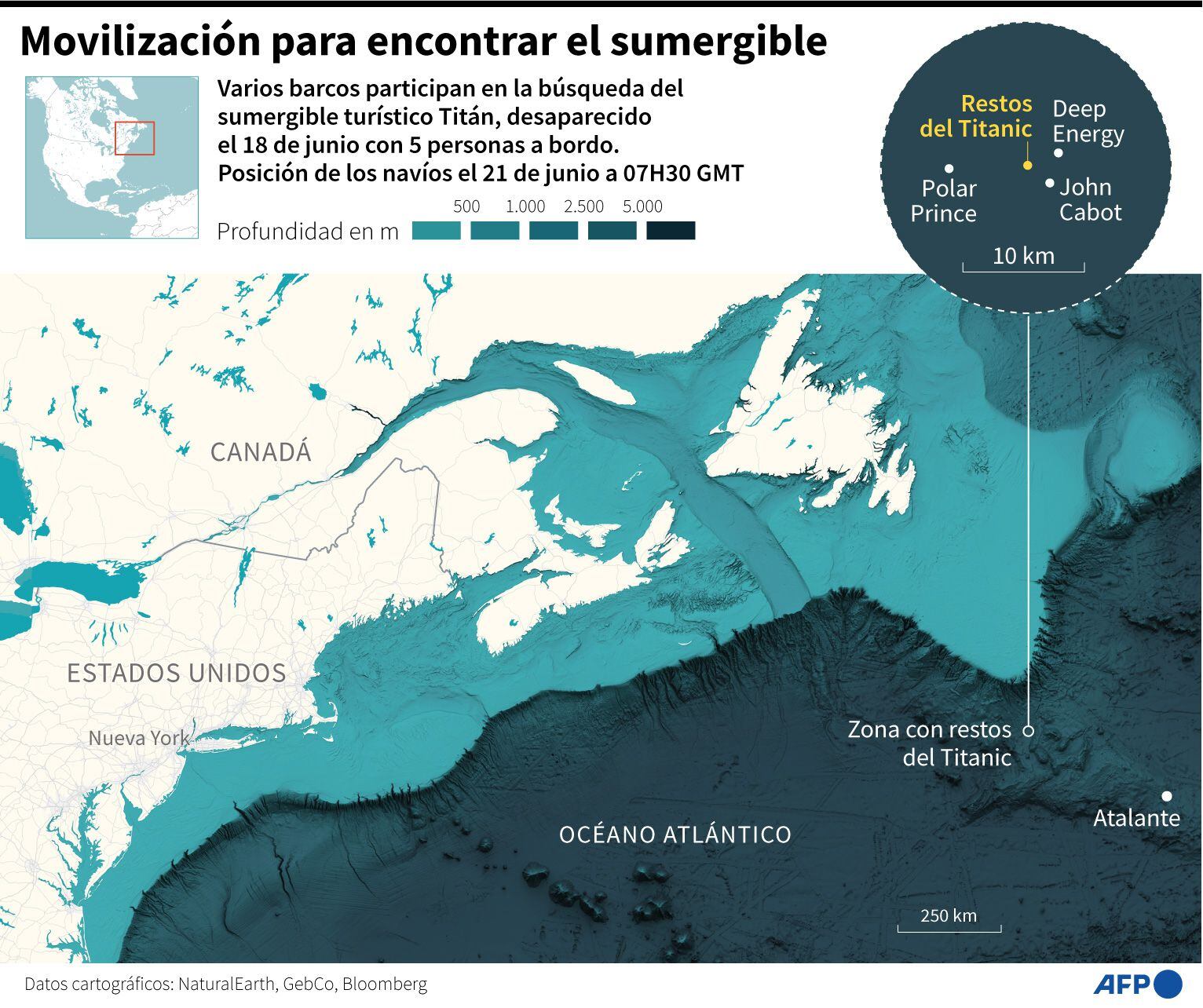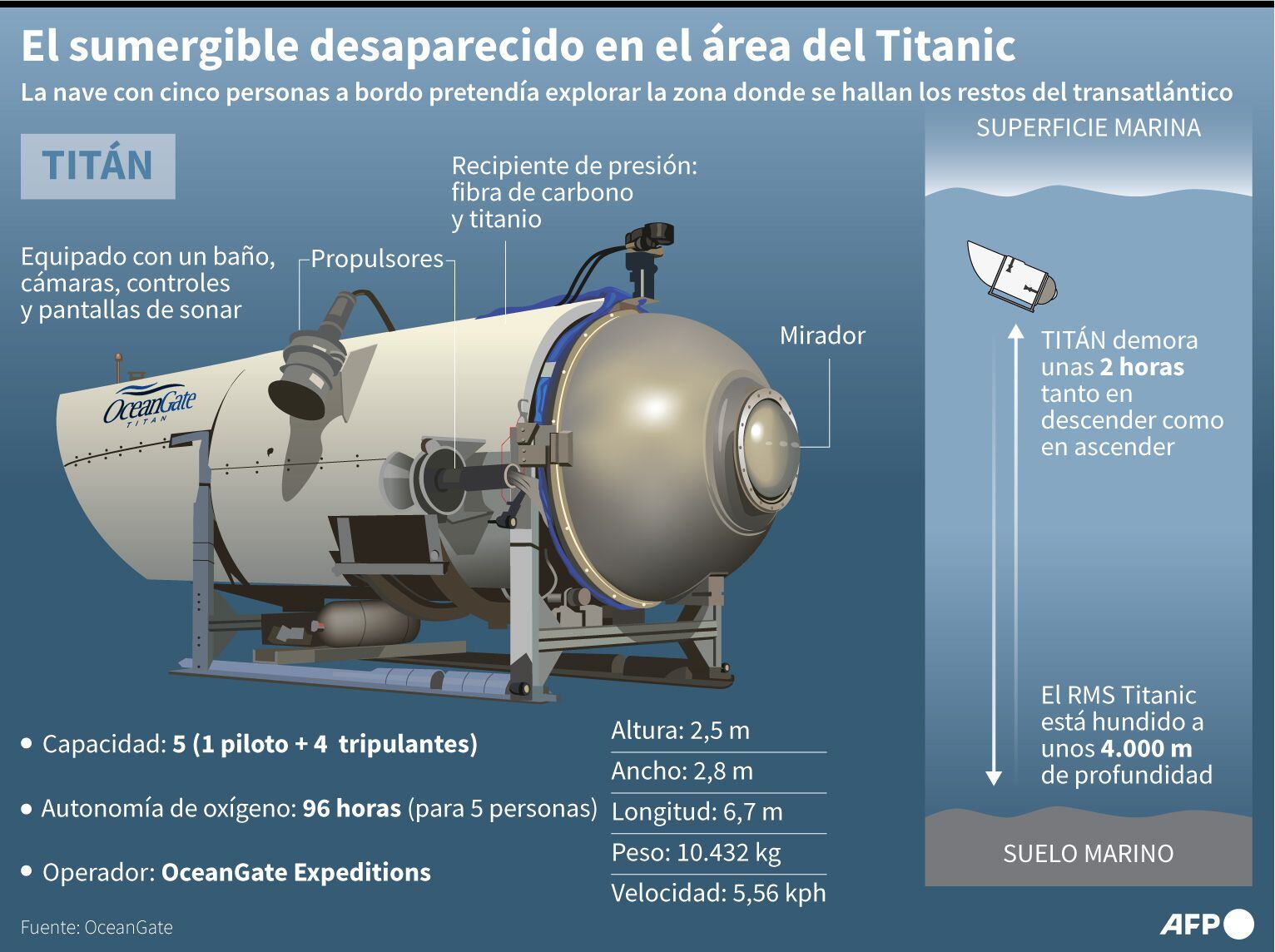Finding the submersible that disappeared on Sunday in the vastness of the Atlantic Ocean is a daunting task full of extreme challenges.
When less than 24 hours of oxygen remain in the Titanwhich was lost while going to the bottom of the sea with five crew members to explore the remains of the titanicin the early hours of this Wednesday the rescue teams detected “underwater noises” in the area of the disappearance, the United States Coast Guard reported.
LOOK: A billionaire, a father and his son, a renowned explorer: who are the 5 passengers on the Titanic submarine?
“The Canadian P-3 aircraft detected noises underwater in the search area. As a result, ROV (Remotely Operated Vehicle) operations were relocated in an attempt to explore the source of the noises.” the United States Coast Guard First District said on Twitter.
The ROV’s searches “have returned negative results but are continuing,” he added.
CNN also reported that “additional acoustic signals have been heard that will help direct surface resources while holding out hope of finding survivors.”
the submersible Titan lost communication on Sunday almost two hours after it began the descent to 3,800 meters deep, where the titanic.
With communications lost, now it is not known if Titan it is floating on the surface or submerged at the bottom of the ocean.
On board are the British millionaire Hamish Harding, president of the Action Aviation company; the pakistani shahzada dawoodVice President of Engro, and his son suleman; the french diver Paul-Henri Nargeolet and Stockton RushCEO of OceanGate Expeditions, the company that operates the submersible.

The cost to explore the titanic in the submersible Titan is $250,000 per person.
But what are the extreme conditions rescuers face to find the titan submersible?
the submersible Titan disappeared about 1,500 kilometers from Cape Cod, in Massachusetts. In this place the depth of the Atlantic Ocean is 4,000 meters. It is also located almost 700 kilometers from Newfoundland, in Canada.
Rescuers search for Titan in an area of 25,000 square kilometers, a surface similar to Haiti or the La Libertad region in Peru.

As Univision explains, the closest place to the search site is St. John’s, in Newfoundland, Canada. So, the almost 700 kilometers of distance mean that if new equipment is required for the job, it would take time to arrive.
Thus, for example, the ships that carry the CURV-21, the most powerful underwater drone of the United States Navy, move at a speed of only 32 kilometers per hour.
john maugercommander of the United States Coast Guard, explained the climatic conditions in which the search is carried out. He said visibility on the surface is limited due to heavy fog, and waves are up to two meters high.
For his part, the meteorologist for The New York Times newspaper explained that on Tuesday the winds in the area were between 16 and 32 kilometers per hour, but warned that in the following days they will be more intense. This will also contribute to increasing the size of the waves.
“It’s a remote area, and it’s challenging to conduct a search in that remote area,” said John Mauger.
He Titan It is capable of reaching a depth of 4,000 meters, explained Univisión. Sunlight reaches up to 1,000 metershenceforth the ocean is completely dark.
How do you search that deep? In this environment, rescue teams become dependent on sonar technology, which It is a device that is used to detect submarines, mines and any submerged object or mass. When the sonar wave pulses hit objects, they are reflected on the surfaceand thus the distance at which they are can be determined.
According to Univisión, the rescue teams of Canada have released sonars to perceive any sign of Titanbut experts have warned that more sophisticated tools are required.
Jamie Pringle, a researcher at Keele University, told the BBC that “At that depth, a sonar search system would have to be very specialized to arrive at a frequency high enough to find a small submersible.”
The depth of the sea “is like being in space, it’s the same danger and the same difficulty,” Chris Parry, a retired admiral in the British Navy, told Sky News.

One possibility is that the submersible be on the surface. If that’s the case, it’s also hard to locate.
He submersible it is only 6.7 meters long, an insignificant size in the vastness of the sea. In addition, it is designed so that only a small part of the ship floats. The rest remains in the sea. Thus, seeing it from a distance, with extreme weather conditions, becomes an almost impossible task.

Another key detail is that the Titan it only opens from the outside. That is, if it is floated, its crew members cannot do anything to get oxygen if the 96-hour reserve runs out.
“Try find something like that from the airparticularly if they have run out of power and are unable to send signals, it will be a real challenge,” researcher Jamie Pringle told the BBC.
If the search in the depths depends only on the detection of sounds related to the Titanbringing it to the surface once it is found is another major challenge.
Univisión explained what those challenges are: divers trained for sea rescue can only go a few meters deep, a tiny fraction of the distance required to reach the submersible if it remains at a depth of 4,000 meters. The teams that do have the capacity to reach that place are few, expensive and difficult to move, he remarked.
Marine engineering professor Alistair Greig told Reuters that if the crew is at the bottom of the sea, a robot may have to be sent to bring the entire boat to the surface. He added that there are very few robots of this type.
“You won’t be able to transfer them to another ship at depth. You’ll have to get the whole submersible up and then get them out, get some sort of robot ship down there to attach something to help get them up and then extract them. This is all going to take a long time.” explained the University College London professor.

Eric Fusil, an Adjunct Professor and Director of the Shipbuilding Center at the University of Adelaide, spoke of various scenarios: a power failure, a fire, a flood or that Titan got tangled up with something.
According to the AP agency, he explained that a fire could disable the ship’s systems or create toxic gases that could have left the crew unconscious. Whereas a flood would cause an almost immediate implosion.
The professor commented that the most optimistic scenario is that of a loss of power that makes it impossible for the submersible to return to the surface. In that case, it just depends on the search parties locating it in time.
“The bottom line is that it would be easier to go and rescue people in space than to go down to that depth to rescue them, because you can’t communicate that easily,” he said. “It’s still a very, very risky thing, even with today’s technology.”
Source: Elcomercio
I am Jack Morton and I work in 24 News Recorder. I mostly cover world news and I have also authored 24 news recorder. I find this work highly interesting and it allows me to keep up with current events happening around the world.

:quality(75)/cloudfront-us-east-1.images.arcpublishing.com/elcomercio/6A7GT7B73VEZTO34FIYCRFVEZA.jpg)

:quality(75)/cloudfront-us-east-1.images.arcpublishing.com/elcomercio/SURQNISTGJCVNONLBAUWMYOD2Y.jpg)
:quality(75)/cloudfront-us-east-1.images.arcpublishing.com/elcomercio/CBPCX6OQ6VDTTDCMCTGZFCXOKE.jpg)
:quality(75)/cloudfront-us-east-1.images.arcpublishing.com/elcomercio/R3BFGYGHNBENTF2OR7JTO7S67U.jpg)

